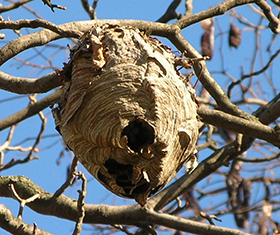Pest Problems After Storms – Wasps
go.ncsu.edu/readext?429131
en Español / em Português
El inglés es el idioma de control de esta página. En la medida en que haya algún conflicto entre la traducción al inglés y la traducción, el inglés prevalece.
Al hacer clic en el enlace de traducción se activa un servicio de traducción gratuito para convertir la página al español. Al igual que con cualquier traducción por Internet, la conversión no es sensible al contexto y puede que no traduzca el texto en su significado original. NC State Extension no garantiza la exactitud del texto traducido. Por favor, tenga en cuenta que algunas aplicaciones y/o servicios pueden no funcionar como se espera cuando se traducen.
Português
Inglês é o idioma de controle desta página. Na medida que haja algum conflito entre o texto original em Inglês e a tradução, o Inglês prevalece.
Ao clicar no link de tradução, um serviço gratuito de tradução será ativado para converter a página para o Português. Como em qualquer tradução pela internet, a conversão não é sensivel ao contexto e pode não ocorrer a tradução para o significado orginal. O serviço de Extensão da Carolina do Norte (NC State Extension) não garante a exatidão do texto traduzido. Por favor, observe que algumas funções ou serviços podem não funcionar como esperado após a tradução.
English
English is the controlling language of this page. To the extent there is any conflict between the English text and the translation, English controls.
Clicking on the translation link activates a free translation service to convert the page to Spanish. As with any Internet translation, the conversion is not context-sensitive and may not translate the text to its original meaning. NC State Extension does not guarantee the accuracy of the translated text. Please note that some applications and/or services may not function as expected when translated.
Collapse ▲
Baldfaced hornet nest in tree.
In the late summer and early fall, wasp colonies are close to full size. Flooding and winds during this time may damage the nests, disrupting the colonies and even leaving them homeless. Fallen trees may contain baldfaced hornet (image at right) or European hornet nests. Paper wasp nests may be found on eaves, roof overhangs or under porches and other protected areas of buildings. Hornet nests may also be found in shrubs.. Yellow jackets may be flooded out of their underground nesting sites. Numerous adults will be seen flying around the nest site and may also be attracted to any outdoor foods and exposed trash. Yellow jackets are often attracted to freshly cut and broken wood for the sap or as nesting material. Be cautious when cutting trees and removing branches and other debris. Watch where you step and look for yellow jacket nests in the ground. Normally, unless a nest is right nearby, the wasps are probably out foraging and are less likely to sting.
However, they may become entangled in your clothing or you might grab one accidentally when handling limbs. In these situation, they might sting you. As with summer and fall picnics, beverages along with food being cooked and/or consumed outdoors will also attract wasps. Here are some other suggestions for avoiding stings:
- Do not swat insects that land on you. Instead, flick them off. Avoid wearing perfumes or colognes that might attract wasps and bees. Insect repellents are typically not effective against stinging pests.
- When eating outdoors, keep all food and drinks covered when they are not being consumed. Drinking from cans may be convenient but you may not notice a yellow jacket entering the can in search of water and/or sugar. Dispose of food scraps and beverage containers in trash bags and, preferably, inside trash cans. Keep trash cans covered.
- Wear protective clothing such as gloves, boots, long pants and a hat. Although they may be uncomfortable, particularly if the weather is warm, they are highly recommended when doing storm cleanup in general.



